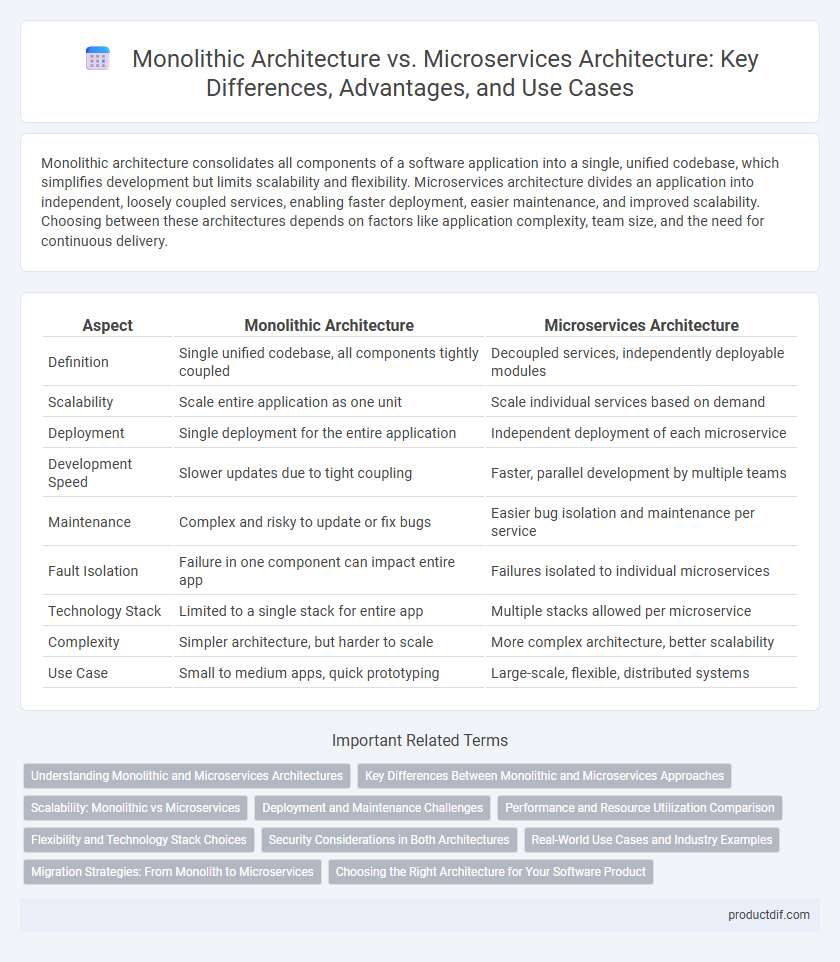Monolithic architecture consolidates all components of a software application into a single, unified codebase, which simplifies development but limits scalability and flexibility. Microservices architecture divides an application into independent, loosely coupled services, enabling faster deployment, easier maintenance, and improved scalability. Choosing between these architectures depends on factors like application complexity, team size, and the need for continuous delivery.
Table of Comparison
| Aspect | Monolithic Architecture | Microservices Architecture |
|---|---|---|
| Definition | Single unified codebase, all components tightly coupled | Decoupled services, independently deployable modules |
| Scalability | Scale entire application as one unit | Scale individual services based on demand |
| Deployment | Single deployment for the entire application | Independent deployment of each microservice |
| Development Speed | Slower updates due to tight coupling | Faster, parallel development by multiple teams |
| Maintenance | Complex and risky to update or fix bugs | Easier bug isolation and maintenance per service |
| Fault Isolation | Failure in one component can impact entire app | Failures isolated to individual microservices |
| Technology Stack | Limited to a single stack for entire app | Multiple stacks allowed per microservice |
| Complexity | Simpler architecture, but harder to scale | More complex architecture, better scalability |
| Use Case | Small to medium apps, quick prototyping | Large-scale, flexible, distributed systems |
Understanding Monolithic and Microservices Architectures
Monolithic architecture integrates all software components into a single, unified codebase, enabling straightforward development but limiting scalability and flexibility. Microservices architecture decomposes applications into independently deployable services, enhancing modularity, scalability, and fault isolation. Understanding the distinctions between monolithic and microservices architectures is crucial for optimizing software design, deployment strategies, and maintenance workflows.
Key Differences Between Monolithic and Microservices Approaches
Monolithic architecture centralizes all components of a software application into a single, unified codebase, which can lead to simpler initial development but challenges in scalability and deployment. Microservices architecture divides the application into independent services, each responsible for specific business functions, enabling greater flexibility, scalability, and faster continuous delivery. Key differences include deployment independence, technology stack diversity, fault isolation, and the complexity of inter-service communication.
Scalability: Monolithic vs Microservices
Monolithic architecture faces scalability challenges as the entire application must be scaled together, leading to resource inefficiency and complexity during peak loads. In contrast, microservices architecture enhances scalability by enabling independent scaling of individual services based on demand, optimizing resource utilization and improving system resilience. Kubernetes and Docker are commonly used to orchestrate and deploy scalable microservices, facilitating granular control over performance and load distribution.
Deployment and Maintenance Challenges
Monolithic architecture often faces deployment challenges due to its large, tightly coupled codebase requiring the entire application to be rebuilt and redeployed for updates, increasing downtime risk. Microservices architecture allows independent deployment of smaller, loosely coupled services, simplifying updates and reducing downtime but complicates maintenance with distributed system requirements like service orchestration and network reliability. Both architectures demand robust monitoring and automated deployment pipelines to manage complexity and ensure system reliability effectively.
Performance and Resource Utilization Comparison
Monolithic architecture often demonstrates faster intra-process communication due to its unified codebase, resulting in lower latency for certain tasks compared to microservices. However, microservices architecture excels in resource utilization by enabling independent scaling of services, optimizing CPU and memory allocation based on demand. Performance in microservices can be impacted by network overhead and inter-service communication but benefits from fault isolation and flexibility in deploying resources.
Flexibility and Technology Stack Choices
Monolithic architecture limits flexibility by bundling all components into a single deployable unit, restricting technology stack choices to a uniform platform. Microservices architecture enhances flexibility through independent, loosely coupled services, enabling teams to select diverse technologies best suited for each service's functionality. This approach accelerates development cycles and facilitates scalability by decoupling dependencies inherent in monolithic systems.
Security Considerations in Both Architectures
Monolithic architecture centralizes security management, simplifying enforcement but increasing risk, as a single breach can compromise the entire system, whereas microservices architecture enhances security by isolating services, limiting the attack surface, and enabling granular access control. Microservices require robust inter-service communication security through methods like API gateways, mutual TLS, and service meshes to prevent unauthorized access and ensure data integrity. Implementing distributed tracing and centralized logging is critical in microservices for effective threat detection and compliance auditing across diverse components.
Real-World Use Cases and Industry Examples
Monolithic architecture is commonly employed in legacy enterprise systems like traditional banking platforms where unified codebases ensure straightforward deployment and centralized management. Microservices architecture powers scalable solutions in technology giants such as Netflix and Amazon, enabling independent service deployment, fault isolation, and continuous delivery. Industry sectors including e-commerce, finance, and telecommunications increasingly adopt microservices to accelerate innovation, improve system resilience, and enhance user experience through modular development.
Migration Strategies: From Monolith to Microservices
Migrating from monolithic architecture to microservices requires carefully decomposing the monolith into independent, loosely coupled services to improve scalability and maintainability. Strategies such as the Strangler Fig pattern enable incremental migration by gradually replacing monolithic components with microservices while minimizing downtime. Effective migration also involves refactoring databases into service-specific stores and implementing robust API gateways to manage inter-service communication and data consistency.
Choosing the Right Architecture for Your Software Product
Choosing the right architecture for your software product depends on factors like scalability, development speed, and maintainability. Monolithic architecture offers simplicity and easier initial deployment, while microservices architecture provides flexibility, independent deployment, and improved fault isolation. Evaluate your team's expertise, project complexity, and future growth plans to determine the best fit between monolithic and microservices architectures.
Monolithic Architecture vs Microservices Architecture Infographic

 productdif.com
productdif.com